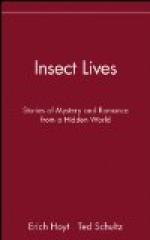or just before the imago has to emerge (caddis-flies);
working its way out of the ground (crane-flies) or
coming half-way out of its cocoon (many moths).
The pupa of the higher insects almost certainly corresponds
with the may-fly’s sub-imago, and the facts just
recalled as to remnants of pupal activity suggest
that in the ancestors of endopterygote insects what
is now the pupal instar was represented by an active
nymphal or sub-imaginal stage, possibly indeed by more
than one stage, as Packard and other writers have
stated that pupae of bees and wasps undergo two or
three moults before the final exposure of the imago.
Such an early pupal instar has been defined as a ‘pro-nymph’
or a ‘semi-pupa.’ Examples have been
given of the exceptional passive condition of the
penultimate instar in Exopterygota. The instars
preceding this presumably had originally outward wing-rudiments
in all insect life-histories, and the endopterygote
condition was attained by the postponement of the
outward appearance of these to successively later
stages. The leg and wing rudiments of the male
coccid (pp. 20-1) beneath the cuticle of the second
instar are strictly comparable to imaginal buds, and
these are present in one instar of what is generally
regarded as an exopterygote life-history. The
first instar in all insects has no visible wing-rudiments,
but when they grow outwardly from the body, they necessarily
become covered with cuticle, so that they must be
visible after the first moult. There is no supreme
difficulty in supposing that the important change
was for these early rudiments to become sunk into
the body, so that the cuticle of the second, and,
later, of the third and succeeding instars, showed
no outward sign of their presence. This suggestion
is confirmed by Heymons’ (1896, 1907) observation
of the occasional appearance of outward wing-rudiments
on the thoracic segments of a mealworm, the larva
of the beetle Tenebrio molitor, and by F. Silvestri’s
discovery (1905) of a ‘pro-nymph’ stage
with short external wing-rudiments between the second
larval and the pupal instars of the small ground-beetle
Lebia scapularis. Whatever may be the
exact explanation of these abnormalities, they show
that in the life-story of the higher insects outward
wing-rudiments may even yet appear before the pupal
stage, confirming our belief that such appearance
is an ancestral character. The inward growth of
these wing-rudiments may well have been correlated
with a difference in form between the newly-hatched
insect and its parent. As this difference persisted
until a constantly later stage, and the pre-imaginal
instar became necessarily a stage for reconstruction,
the present condition of complete metamorphosis in
the more highly organised orders was finally attained.




